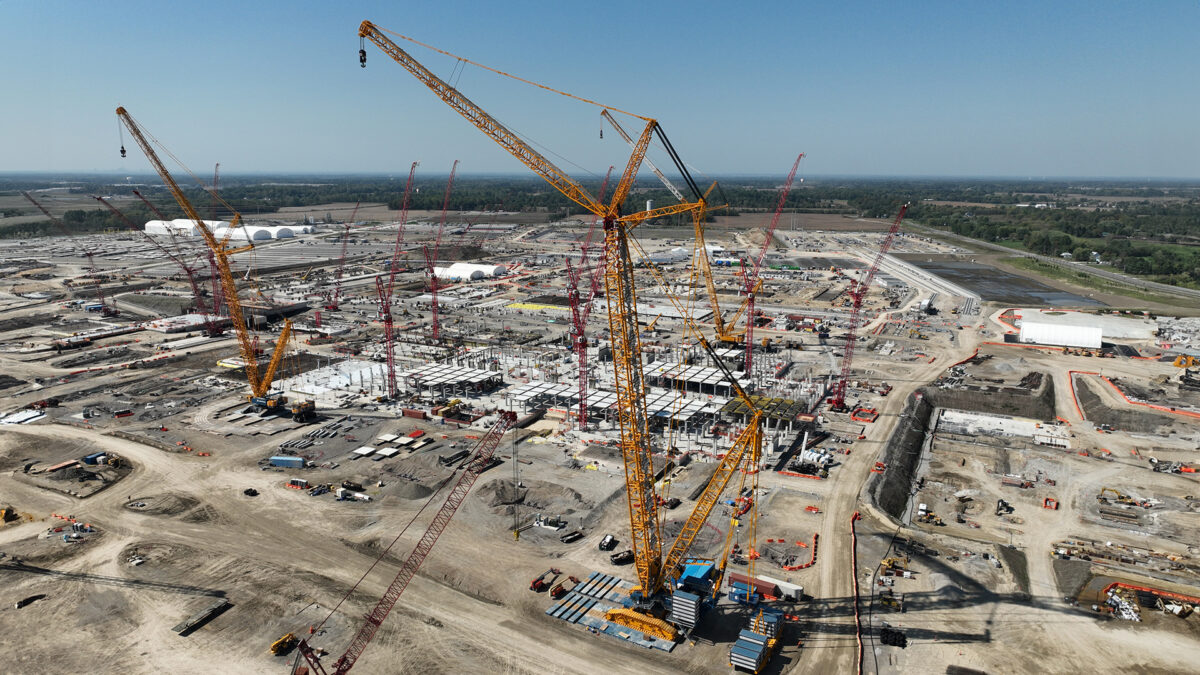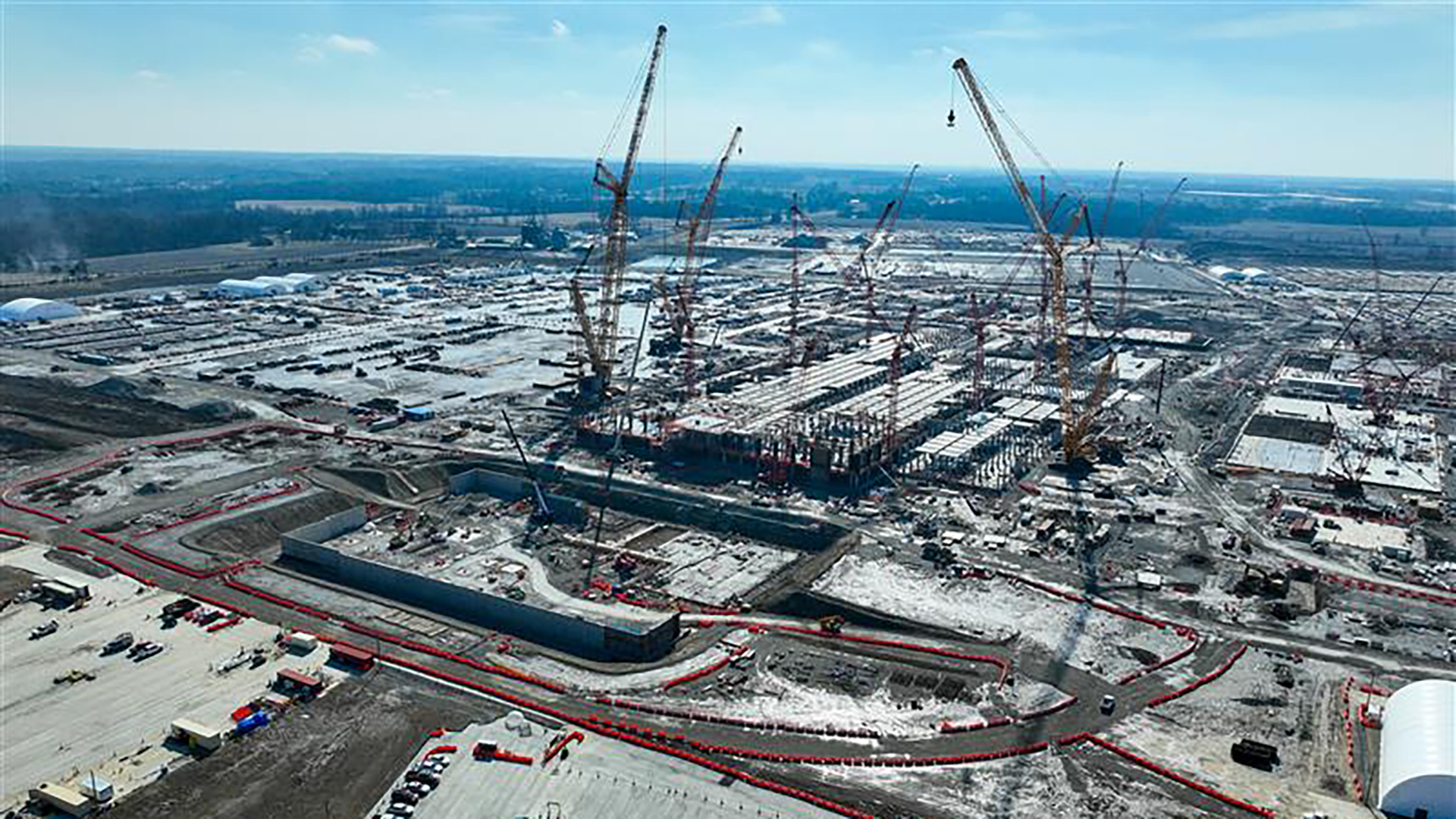Intel, Biden-Harris Administration Finalize $7.86 Billion Funding Award Under US CHIPS Act

The students of Johnstown Monroe Intermediate School named the powerful crane "Ms. Armstrong,” paying homage to Ohio’s history in innovation, aviation and space. Standing taller than two Statues of Liberty, this impressive crane can lift 5.5 million pounds.(Credit: Intel Corporation)
Award to support Intel’s $100 billion investment plans to expand American semiconductor manufacturing and technology leadership.
Download a full set of images from Intel’s Ohio One construction project (ZIP, 88 MB)
NEWS HIGHLIGHTS
- The U.S. Department of Commerce has awarded Intel up to $7.86 billion in direct funding through the U.S. CHIPS and Science Act to advance Intel’s commercial semiconductor manufacturing and advanced packaging projects in Arizona, New Mexico, Ohio and Oregon.
- This direct funding is in addition to the $3 billion contract awarded to Intel for the Secure Enclave program that is designed to expand trusted manufacturing of leading-edge semiconductors for the U.S. government.
- Today’s award, coupled with a 25% investment tax credit, will support Intel’s plans to invest more than $100 billion in the U.S.
- As previously announced, Intel’s planned U.S. investments, including projects beyond those supported by CHIPS, support more than 10,000 company jobs, nearly 20,000 construction jobs, and more than 50,000 indirect jobs with suppliers and supporting industries.
SANTA CLARA, Calif., Nov. 26, 2024 – Intel Corporation and the Biden-Harris Administration announced today that the U.S. Department of Commerce and Intel have reached agreement on terms to award the company up to $7.86 billion in direct funding for its commercial semiconductor manufacturing projects under the U.S. CHIPS and Science Act. The award will support Intel’s previously announced plans to advance critical semiconductor manufacturing and advanced packaging projects at its sites in Arizona, New Mexico, Ohio and Oregon. Intel also plans to claim the U.S. Treasury Department’s Investment Tax Credit, which is expected to be up to 25% of qualified investments of more than $100 billion.
“With Intel 3 already in high-volume production and Intel 18A set to follow next year, leading-edge semiconductors are once again being made on American soil,” said Pat Gelsinger, CEO of Intel. “Strong bipartisan support for restoring American technology and manufacturing leadership is driving historic investments that are critical to the country’s long-term economic growth and national security. Intel is deeply committed to advancing these shared priorities as we further expand our U.S. operations over the next several years.”
The announcement demonstrates the U.S. government’s confidence in Intel’s essential role in building a resilient, trusted semiconductor supply chain on domestic soil. Since the passage of the CHIPS and Science Act more than two years ago, Intel has announced plans to invest more than $100 billion in the U.S. to expand chipmaking and advanced packaging capacity and capabilities critical to economic and national security. The historic investments will support tens of thousands of jobs, strengthen U.S. supply chains, foster U.S.-based R&D, and help ensure American leadership in cutting-edge semiconductor manufacturing and technology capabilities.
Press Kit: U.S. CHIPS Act Funding for Intel
“The CHIPS for America program will supercharge American technology and innovation and make our country more secure – and Intel is expected to play an important role in the revitalization of the U.S. semiconductor industry,” said U.S. Secretary of Commerce Gina Raimondo. “Thanks to the leadership of President Biden and Vice President Harris, our CHIPS award is catalyzing Intel to make one of the largest investments in semiconductor manufacturing in U.S. history.”
The award follows the previously signed preliminary memorandum of terms and the completion of Commerce’s due diligence, in addition to the announced investment tax credit. The final total award is less than the proposed preliminary award due to a congressional requirement to use CHIPS funding to pay for the $3 billion Secure Enclave program.
U.S. Manufacturing and R&D Investments
The CHIPS Act award will directly support Intel’s investments at sites where the company develops and produces many of the world’s most advanced chips and semiconductor packaging technologies, including in Arizona, the Silicon Desert; New Mexico, the Silicon Mesa; Ohio, the Silicon Heartland; and Oregon, the Silicon Forest.
- Arizona: Intel’s U.S. Manufacturing Powerhouse (Silicon Desert Fact Sheet)
- New Mexico: Intel’s U.S. Advanced Packaging Site (Silicon Mesa Fact Sheet)
- Ohio: Intel’s New Leading-Edge Manufacturing Site (Silicon Heartland Fact Sheet)
- Oregon: The Heart of Intel’s Semiconductor R&D (Silicon Forest Fact Sheet)
Intel was founded in the U.S. and has been innovating, investing and supporting global semiconductor manufacturing and R&D for more than 50 years. Intel currently employs approximately 45,000 people in the U.S.
Foundry Momentum and Technology Leadership
Intel is nearing completion of a historic pace of semiconductor node development to regain process technology leadership. Intel 18A, the company’s fifth process node in four years, is on track to launch in 2025 and continues to gain traction with customers. The company is finalizing a multiyear, multibillion-dollar commitment by Amazon Web Services to expand its existing partnership to include a new custom Intel® Xeon® 6 chip on Intel 3 and a new AI fabric chip on Intel 18A.
In September 2024, Intel won a manufacturing contract for up to $3 billion for the Secure Enclave program. This program is designed to expand the trusted manufacturing of leading-edge semiconductors for the U.S. government and builds on Intel’s relationship with the U.S. Department of Defense through the Rapid Assured Microelectronics Prototypes - Commercial (RAMP-C) and State-of-the-Art Heterogeneous Integrated Packaging (SHIP) programs.
Additionally, Intel reported key milestones in advanced semiconductor manufacturing with the completed assembly of the industry’s first commercial High Numerical Aperture (High NA) Extreme Ultraviolet (EUV) lithography scanner and receipt of an additional High NA tool installed at the company’s Hillsboro, Oregon, R&D site. This will enable Intel to lead cutting-edge advancements that will define next-generation chip manufacturing.
Workforce Development and Childcare Benefits
Alongside its manufacturing and technology investments, Intel has a long-standing history of investing in the American workforce by supporting education, training and benefits programs needed to create the jobs of the future. In 2022, for example, Intel announced a $100 million investment to expand semiconductor education, research and workforce training opportunities across the nation.
As part of Intel’s overall CHIPS award, $65 million is set aside to support the company’s efforts to create a more skilled semiconductor workforce. Intel plans to use $56 million to help train students and faculty at all education levels to support industry growth. This includes, for example, Intel’s recently launched U.S. registered apprenticeship program for manufacturing facility technicians.
The company will use $5 million of the dedicated workforce award to help increase childcare availability near Intel’s facilities. This is intended to support Intel’s recently announced plans to broaden childcare benefits and pilot innovative programs to support working families. The remaining $4 million of the $65 million award will support Intel’s participation in the CHIPS Women in Construction Framework, which Intel voluntarily committed to this year to help expand the construction workforce by increasing the participation of women and economically disadvantaged individuals.
Finally, Intel is partnering with the Midwest Microelectronics Consortium (MMEC) as its members receive funding for five technology development projects within the Microelectronics Commons initiative established under the CHIPS Act. These projects will engage more than 30 MMEC members representing organizations from industry, academia and government stakeholders to advance domestic microelectronic technology development to deliver solutions to strengthen the U.S.-based supply chain.
Forward-Looking Statements
This release contains forward-looking statements that involve a number of risks and uncertainties. Words such as "accelerate", "achieve", "aim", "ambitions", "anticipate", "believe", "committed", "continue", "could", "designed", "estimate", "expect", "forecast", "future", "goals", "grow", "guidance", "intend", "likely", "may", "might", "milestones", "next generation", "objective", "on track", "opportunity", "outlook", "pending", "plan", "position", "possible", "potential", "predict", "progress", "ramp", "roadmap", "seek", "should", "strive", "targets", "to be", "upcoming", "will", "would", and variations of such words and similar expressions are intended to identify such forward-looking statements, which may include statements regarding:
- our business plans and strategy and anticipated benefits therefrom, including with respect to our IDM 2.0 strategy, Smart Capital strategy, partnerships with Apollo and Brookfield, internal foundry model, updated reporting structure, and AI strategy;
- projections of our future financial performance, including future revenue, gross margins, capital expenditures, and cash flows;
- projected costs and yield trends;
- future cash requirements, the availability, uses, sufficiency, and cost of capital resources, and sources of funding, including for future capital and R&D investments and for returns to stockholders, such as stock repurchases and dividends, and credit ratings expectations;
- future products, services, and technologies, and the expected goals, timeline, ramps, progress, availability, production, regulation, and benefits of such products, services, and technologies, including future process nodes and packaging technology, product roadmaps, schedules, future product architectures, expectations regarding process performance, per-watt parity, and metrics, and expectations regarding product and process leadership;
- investment plans and impacts of investment plans, including in the U.S. and abroad;
- internal and external manufacturing plans, including future internal manufacturing volumes, manufacturing expansion plans and the financing therefor, and external foundry usage;
- future production capacity and product supply;
- supply expectations, including regarding constraints, limitations, pricing, and industry shortages;
- plans and goals related to Intel's foundry business, including with respect to anticipated customers, future manufacturing capacity and service, technology, and IP offerings;
- expected timing and impact of acquisitions, divestitures, and other significant transactions, including the sale of our NAND memory business;
- expected completion and impacts of restructuring activities and cost-saving or efficiency initiatives;
- future social and environmental performance goals, measures, strategies, and results;
- our anticipated growth, future market share, and trends in our businesses and operations;
- projected growth and trends in markets relevant to our businesses;
- anticipated trends and impacts related to industry component, substrate, and foundry capacity utilization, shortages, and constraints;
- expectations regarding government incentives;
- future technology trends and developments, such as AI;
- future macro environmental and economic conditions;
- geopolitical tensions and conflicts and their potential impact on our business;
- tax- and accounting-related expectations;
- expectations regarding our relationships with certain sanctioned parties; and
- other characterizations of future events or circumstances.
Such statements involve many risks and uncertainties that could cause our actual results to differ materially from those expressed or implied, including those associated with:
- the high level of competition and rapid technological change in our industry;
- the significant long-term and inherently risky investments we are making in R&D and manufacturing facilities that may not realize a favorable return;
- the complexities and uncertainties in developing and implementing new semiconductor products and manufacturing process technologies;
- our ability to time and scale our capital investments appropriately and successfully secure favorable alternative financing arrangements and government grants;
- implementing new business strategies and investing in new businesses and technologies;
- changes in demand for our products;
- macroeconomic conditions and geopolitical tensions and conflicts, including geopolitical and trade tensions between the US and China, the impacts of Russia's war on Ukraine, tensions and conflict affecting Israel and the Middle East, and rising tensions between mainland China and Taiwan;
- the evolving market for products with AI capabilities;
- our complex global supply chain, including from disruptions, delays, trade tensions and conflicts, or shortages;
- product defects, errata and other product issues, particularly as we develop next-generation products and implement next-generation manufacturing process technologies;
- potential security vulnerabilities in our products;
- increasing and evolving cybersecurity threats and privacy risks;
- IP risks including related litigation and regulatory proceedings;
- the need to attract, retain, and motivate key talent;
- strategic transactions and investments;
- sales-related risks, including customer concentration and the use of distributors and other third parties;
- our significantly reduced return of capital in recent years;
- our debt obligations and our ability to access sources of capital;
- complex and evolving laws and regulations across many jurisdictions;
- fluctuations in currency exchange rates;
- changes in our effective tax rate;
- catastrophic events;
- environmental, health, safety, and product regulations;
- our initiatives and new legal requirements with respect to corporate responsibility matters; and
- other risks and uncertainties described in this release, our 2023 Form 10-K, and our other filings with the SEC.
Given these risks and uncertainties, readers are cautioned not to place undue reliance on such forward-looking statements. Readers are urged to carefully review and consider the various disclosures made in this release and in other documents we file from time to time with the SEC that disclose risks and uncertainties that may affect our business.
Unless specifically indicated otherwise, the forward-looking statements in this release do not reflect the potential impact of any divestitures, mergers, acquisitions, or other business combinations that have not been completed as of the date of this filing. In addition, the forward-looking statements in this release are based on management's expectations as of the date of this release, unless an earlier date is specified, including expectations based on third-party information and projections that management believes to be reputable. We do not undertake, and expressly disclaim any duty, to update such statements, whether as a result of new information, new developments, or otherwise, except to the extent that disclosure may be required by law.



